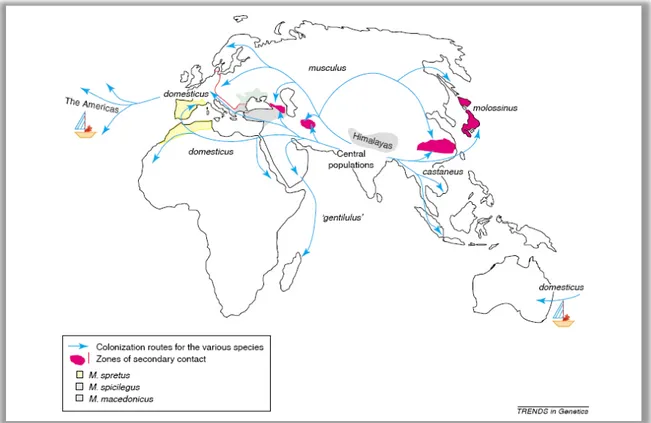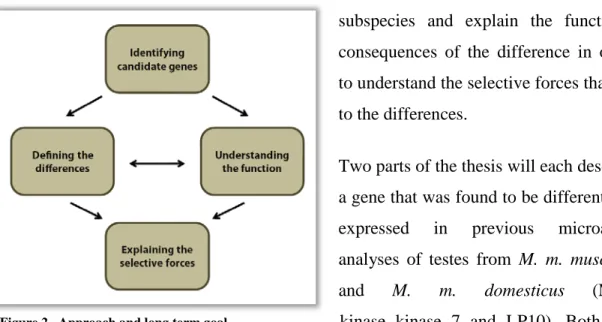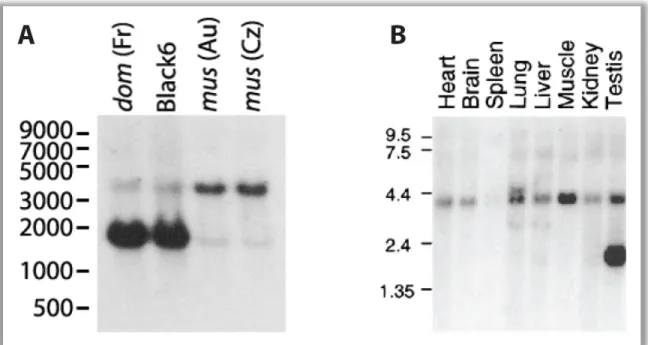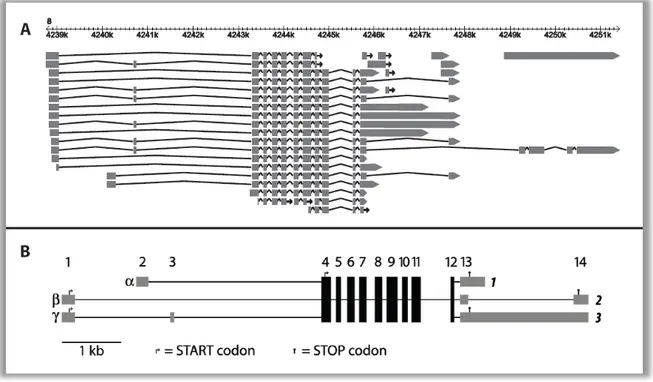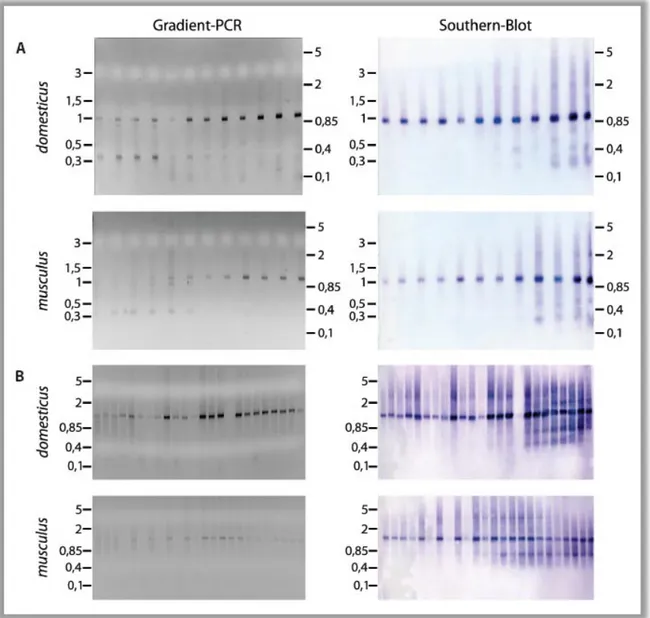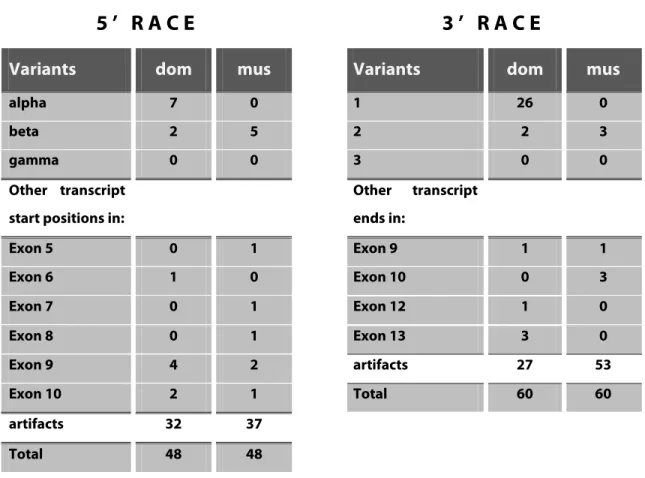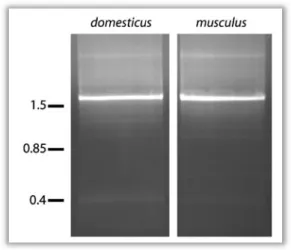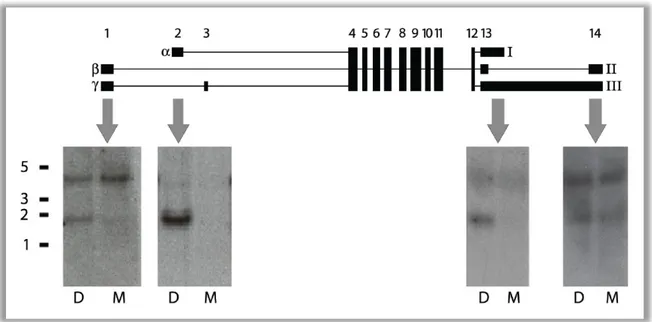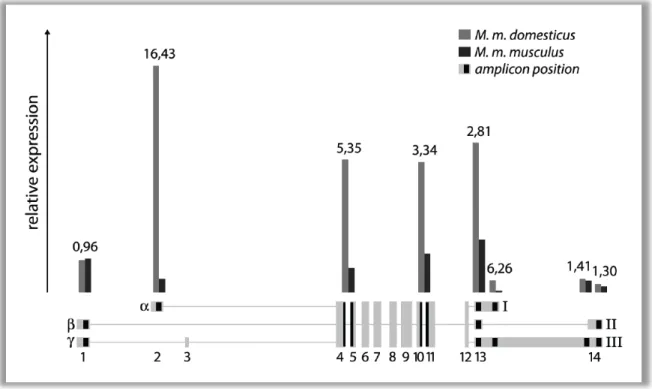Characterization of genes involved in recent adaptation
I n a u g u r a l - D i s s e r t a t i o n
zur
Erlangung des Doktorgrades
der Mathematisch-Naturwissenschaftlichen Fakultät der Universität zu Köln
vorgelegt von
Tobias Johannes Adolf Josef Heinen aus Köln
Köln, 2008
Berichterstatter Prof. Dr. Diethard Tautz Prof. Dr. Peter Nürnberg
Tag der mündlichen Prüfung 17.11.2008
"Es genügt nicht nur, im Allgemeinen von den Naturdingen ein Wissen zu besitzen, sondern wir müssen jedes Naturding danach untersuchen, wie es sich in seiner eigentümlichen Natur verhält. Die Naturwissenschaft hat nicht zum Ziel, das
Tatsächliche zu berichten und einfach hinzunehmen, sondern vielmehr die Ursachen im Naturgeschehen zu ergründen"
Albertus Magnus, 13. Jahrhundert
Zusammenfassung
Hintergrund: Die genetische Ursache adaptiver Evolution liegt in zufälligen Mutationen begründet. Besonders Mutationen in cis-regulatorischen Bereichen von Genen sind im Zusammenhang mit positiver Selektion von großer Bedeutung.
Wildlebende Populationen der Hausmaus (Mus musculus) stellen ein geeignetes Modellsystem dar, um die molekularen Mechanismen von Adaptationsprozessen zu untersuchen. Zwei Unterarten der Hausmaus, Mus musculus musculus und Mus musculus domesticus, prägen in Mitteleuropa eine sekundäre Kontaktzone aus, in der Hybridbildung und daraus resultierende Unfruchtbarkeit vorkommen. Deswegen sind Testis-Gene interessante Beispiele, anhand derer man Artbildungs- und Adaptationsprozesse in beiden Unterarten erforschen kann.
Vergleichende Studien in beiden Unterarten zu Genexpressionscharakteristika und um Adaptationsgene zu identifizieren wurden bereits durchgeführt. Dabei stellte sich heraus, dass die Mitogen-Aktivierte-Proteinkinase-Kinase 7 (Mkk7) und das Orphan- Gen LP10 zwei Gene sind, die sowohl an jüngst stattgefundenen Adaptationsprozessen beteiligt sind, als auch im Testis beider Unterarten differenziell exprimiert werden. Die vorliegende Arbeit beschreibt eine molekulargenetische Analyse beider Gene, die als ein langfristiger Beitrag zur experimentellen Validierung natürlicher Selektion angesehen werden kann.
Vorgehensweise: RACE, Northern-Blot und qRT-PCR Methoden wurden angewendet, um die komplizierten Expressionscharakteristika verschiedener Mkk7-Isoformen in Wildmäusen zu entschlüsseln. Die Testis-Expressionsmuster von Mkk7 wurden in M.
m. musculus und M. m. domesticus mit Hilfe von in situ Hybridisierung untersucht. Die Sequenzierung genomischer DNS in beiden Unterarten führte zu der Entdeckung von Mutationen, die möglicherweise eine Ursache für die unterschiedliche Expression darstellt. Es wurde ein Luciferase-Expressions-System entwickelt, um die Aktivität solcher natürlichen Varianten von Promotoren messen zu können. Anhand von
Western-Blot-Experimenten wurden Konsequenzen der unterschiedlichen Testis- Expression von Mkk7 auf Proteinebene nachvollzogen.
Die Genexpression von LP10 wurde mit Northern-Blot-Experimenten in verschieden Wildmausarten verglichen, um den evolutiven Ursprung des Genes innerhalb des Mäusestammbaums beurteilen zu können. Eine konditionale LP10 Knockout-Linie zur funktionalen Charakterisierung von LP10 in Testis wurde etabliert. Sowohl das männliche Fortpflanzungssystem, als auch Spermien wurden in LP10 Knockout- Mäusen phänotypisiert. Die Genexpression in den Knockout-Mäusen wurde mit der in Wildtyp-Mäusen durch Microarrayanalysen verglichen.
Ergebnisse: Mkk7α1 ist eine Transkript-Isoform, die spezifisch für späte Spermatiden- Stadien in M. m. domesticus ist. Sie kommt nicht in M. m. musculus vor und wird von einem alternativen Promoter exprimiert. Es konnte der Zusammenhang zwischen einer Mutation im proximalen Abschnitt dieses Promoters und einem Expressionsunterschied beschrieben werden, der in Reportergen-Experimenten in Zellkultur gemessen wurde.
Überdies wurde eine potentielle Insulator-Sequenz gefunden, die die Genexpression in anderen Zelltypen außerhalb von Spermatiden reprimiert. Aufgrund der Proteinanalysen konnte das Vorhandensein einer bislang Unbekannten Funktion von Mkk7 in Testis angenommen werden. Die Translation eines neuartigen Peptids wurde postuliert.
Es stellte sich heraus, dass LP10 im Stammbaum der Mäuse de novo aus nichtkodierender Sequenz hervorgegangen ist. Eine orthologe Region ist zwar auch in anderen Säugetieren vorhanden, wird aber nicht transkribiert. Dieses Ergebnis zeigt, dass sogar die de novo Formation von Multi-Exon-Genen möglich ist, ohne dass Genduplikation involviert ist. Der Testis-spezifische Knockout von LP10 resultiert nicht in Unfruchtbarkeit, aber vorläufige Ergebnisse deuten daraufhin, dass LP10 einen Effekt auf Testis-Gewicht und Spermienmotilität haben könnte. Die Microarrayanalysen lassen vermuten, dass LP10 die Expression einiger anderer Gene beeinflusst.
Abstract
Background: Random mutations in natural populations are the genetic basis of adaptive evolution. In particular, it is thought that mutations in cis-regulatory regions of genes are important targets for positive selection. Wild populations of house mouse subspecies (Mus musculus) are a convenient model to study molecular mechanisms of adaptation.
The two subspecies Mus musculus musculus and Mus musculus domesticus form a zone of secondary contact in middle Europe. In this contact zone hybrid formation as well as hybrid infertility have been documented. Therefore testis genes are an interesting subject for investigating ongoing speciation and adaptation processes in both subspecies.
Surveys to compare expression signatures in both subspecies and to find adaptive trait genes were performed previously. Mitogen activated protein kinase kinase 7 (Mkk7) and the orphan gene LP10, were identified as adaptive trait genes differentially expressed in testis of Mus musculus musculus and Mus musculus domesticus. The work presented here describes a molecular genetic analysis of both genes as part of a long term approach to provide experimental evidence for natural selection.
Approach: RACE, Northern blot and qRT-PCR experiments were performed to resolve the details of the complex expression pattern of different isoforms of Mkk7 in wild mice. Testis expression of Mkk7 in M. m. musculus and M. m. domesticus was examined by situ hybridization. Genomic sequencing of both subspecies identified mutations possibly contributing to cis regulatory differences. A luciferase expression system was developed for testing expression strength of Mkk7 promoter variants.
Western blot experiments were performed to follow consequences of Mkk7 expression changes at the protein level.
LP10 expression in different mouse species was assessed in Northern blot experiments to track the origin of the gene in the mouse lineage. A LP10 conditional knock-out mouse line was established to study LP10 function in testis. The male reproductive
organs and spermatozoa of LP10 knock-out mice were phenotyped. Testis expression of knock-out mice and wild-type mice was compared by microarray analysis.
Results: The Mkk7α1 transcript is an isoform specifically expressed in late spermatids in M. m. domesticus. It does not occur in M. m. musculus and is driven by an alternative promoter. A single proximal mutation in this promoter was identified as a possible cause of expression differences in cell culture reporter gene experiments. A potential insulator sequence was found that represses expression in non-testis cells. Evidence for a so far unknown function of Mkk7 in testis is deduced from protein analysis. The translation of a novel peptide is postulated.
It appears that LP10 has evolved de novo from a non-coding sequence in the mouse lineage. An orthologous region is present in other mammals, but is not transcribed. This result show that even a locus with multiple exons can form de novo, without any gene duplications involved. The knockout of LP10 in testis does not lead to infertility, but the preliminary results suggest an effect on testis weight and sperm motility. The microarray analysis suggests that a small number of other genes are affected in LP10 knockout mice.
Content
1 Introduction ... 1
1.1 Evolutionary biology in the era of modern genomics ... 1
1.2 The house mouse as a model in evolutionary biology ... 2
1.3 Aim of the thesis ... 4
2 Mitogen activated protein kinase kinase 7 ... 7
2.1 Mkk7 and MAP-kinase cascades ... 7
2.2 Mkk7 is a potential adaptive trait gene ... 8
2.3 Isoforms of Mkk7 transcripts in testis ... 9
2.3.1 Different Mkk7 transcripts in M. m. musculus and M. m. domesticus ... 9
2.3.2 Quantification of different Mkk7 transcript variants in wild mice ... 16
2.4 Sequence polymorphism in Mkk7 exon 13 ... 20
2.5 Characteristics of the Mkk7 alpha-promoter ... 21
2.5.1 Expression pattern of Mkk7 alpha in testis ... 21
2.5.2 Sequence polymorphism in the Mkk7 alpha promoter region ... 24
2.5.3 Establishing a reporter system for in vivo applications ... 26
2.5.4 Characterization of the Mkk7 alpha promoter by Luciferase reporter Assay ... 31
2.6 Relation of Mkk7 expression to protein status in testis ... 33
2.7 Summary ... 37
3 LP10 ... 38
3.1 LP10 is a potential adaptive trait gene with unknown function ... 38
3.2 Targeting strategy ... 40
3.3 Phenotypic analysis of LP10/Hennes knock-out mice ... 41
3.4 Expression analysis of LP10/Hennes knock-out mice ... 45
3.5 The evolutionary origin of LP10 ... 47
3.6 Summary ... 50
4 Discussion... 51
4.1 LP10 and Hennes ... 51
4.1.1 De novo evolution of LP10 ... 51
4.1.2 Function of LP10 and Hennes ... 53
4.2 Mkk7 ... 54
4.2.1 Regulation and function of Mkk7 in wild mice testis ... 54
4.2.2 Mkk7 is an example for promoter evolution ... 57
4.3 Measuring expression of naturally occurring promoter variants ... 58
4.4 An integrated approach to provide experimental evidence for natural selection ... 59
5 Addendum ... 62
6 Materials and methods ... 65
6.1 Animals ... 65
6.1.1 Wild mice ... 65
6.1.2 Laboratory mice ... 65
6.2 Reagents ... 65
6.2.1 Chemicals and Kits ... 65
6.2.2 Enzymes ... 66
6.2.3 Antibodies ... 66
6.2.4 Primer list ... 67
6.3 DNA samples ... 69
6.4 RNA Samples ... 70
6.5 Procedures ... 70
6.5.1 Dissection of mice ... 70
6.5.2 Extracting RNA from Mouse tissue ... 70
6.5.3 Extracting protein from mouse tissue ... 71
6.5.4 Extracting genomic DNA from Mouse tissue ... 71
6.5.5 Polymerase chain reaction ... 71
6.5.6 DNA sequencing ... 72
6.5.7 Sequencing of wild mouse genomic regions ... 72
6.5.8 RACE ... 73
6.5.9 Generation of cDNA ... 74
6.5.10 Quantitative real time PCR with SYBR green ... 74
6.5.11 TaqMan Assay for Defb6 quantification ... 75
6.5.12 Histological techniques ... 75
6.5.13 In situ hybridization ... 76
6.5.14 Microscopy ... 78
6.5.15 Northern blotting ... 78
6.5.16 Southern blotting ... 79
6.5.17 Western blotting ... 80
6.5.18 Molecular cloning and testing of hrLuc-MYC ... 80
6.5.19 Molecular cloning and testing of Luciflip plasmid ... 81
6.5.20 Mkk7 alpha reporter assay ... 84
6.5.21 Genotyping of LP10 knock-out mice ... 85
6.5.22 Phenotypic analysis of the male reproductive system ... 86
6.5.23 Microarray analysis ... 87
7 Outside services and contribution of other people ... 89
8 References ... 90
9 Supplement A ... 106
10 Supplement B ... 108
11 Supplement C ... 110
12 Supplement D ... 113
13 Digital supplement... 118
14 Danksagung ... 119
15 Erklärung ... 120
1 Introduction
How random mutations in the genomes of organisms lead to adaptation and speciation is of great interest to evolutionary biologists. To compliment genome wide surveys exploring general mechanisms of evolution, understanding the contribution of changes in individual genes to adaptation and speciation is also of great importance. In a growing number of cases it has been possible to decipher the role of individual genes in adaptations. One of the classic examples is the radiation of Darwin’s finches.
Differences in the development of beak shapes were found to be related to differences in expression levels of the calmodulin gene in beak primordia of Darwin’s finches (Abzhanov et al., 2006). Warfarin resistance in rat evolved through selection of mutations in a vitamin K reductase gene (Kohn et al., 2000, 2003; Pelz et al., 2005). In humans, the beta-globin gene which is target of selection related to malaria resistance (Hanchard et al., 2007) and the FOXP2 gene which is involved in the evolution of speech (Enard et al., 2002) are two prominent examples. However, in order to build a more comprehensive understanding of evolutionary mechanisms it will be a future challenge for biologists to dissect more examples of such genotype-phenotype relationships in wild populations in a functional and ecological context.
1.1 Evolutionary biology in the era of modern genomics
A reasonable approach to investigate the genetics of evolutionary changes is the comparison of wild populations of closely related species, subspecies or subpopulations.
The era of modern genomics provides new technologies that facilitate such comparisons (Ellegren and Sheldon, 2008). Acquisition of large amounts of genomic sequence data from wild population samples brings new insights into genome evolution. It also offers the possibility to screen wild populations for so called selective sweep loci. These are genomic regions containing a beneficial mutation that has been target of natural selection leading to fixation of the allele and its linked flanking regions – a process called genetic hitchhiking which results in reduced sequence variability in the vicinity of the sweep (Smith and Haigh, 1974). Selective sweeps can be identified for example
via microsatellite analysis (Ihle et al., 2006; Kauer et al., 2003; Wiehe et al., 2007) or with statistical tests based on genomic sequence data (Fu, 1997; Kim and Stephan, 2002; Tajima, 1989). The invention of microarray technologies allowed the consideration of large amounts of gene expression data. Measuring the expression differences between closely related species can establish a basis for understanding the contribution of expression variation to evolutionary processes (Rottscheidt and Harr, 2007; Voolstra et al., 2007). In the near future, next generation sequencing will gather importance in expression profiling (Torres et al., 2008) and will open up the possibility to compare sequence and expression data, also in non-model organisms and samples of wild populations.
1.2 The house mouse as a model in evolutionary biology
Among mammals, the house mouse Mus musculus (LINNAEUS, 1758) is the best established model organism. It offers a lot of genomic resources, it serves as a genetic model for human traits and, in particular, it provides a large variety of fundamental and unique tools for experimental application, such as homologous recombination in embryonic stem cells. In addition to the research that has been carried out using inbred strains, studies involving wild mice have amassed basic knowledge about the ecology and population structure of this species making it also an attractive model for evolutionary studies.
The taxon Mus is split into different sub-taxa (Chevret et al., 2005), which have spread over the entire globe. The house mouse lineage itself consists of different subgroups.
This phylogenetic diversification is believed to be the result of a radiation that took place in the Northern part of the Indian sub-continent (Boursot et al., 1993). The three best characterized subgroups within the Mus musculus lineage are Mus musculus domesticus (Western Europe and areas that have been colonized by Western European nations), Mus musculus musculus (Eastern Europe and Northern Asia) and Mus musculus castaneus (Southeast Asia). These groups can also be seen as the progenitors of the common laboratory strains, which are mostly genetic mixtures of all three
Figure 1 Geographical distribution and routes of colonization of different mouse species and subspecies. The illustration is an original picture from “Trends in Genetics” (Guenet and Bonhomme, 2003).
subspecies (Bonhomme et al., 1987). Questions regarding the origin and the ancestral populations of Mus musculus and questions of whether the subpopulations should be regarded as distinct species or as different subspecies are still the subjects of ongoing debate. In the following, the subgroups of Mus musculus will be called subspecies as commonly used in the literature.
Figure 1 illustrates the geographical distribution and colonization routes of the main subspecies. The different subspecies are separated by contact zones in which hybrid formation occurs. A well-defined hybrid zone between mouse subspecies is formed by M. m domesticus and M. m. musculus (Hunt and Selander, 1973; Sage et al., 1986;
Teeter et al., 2008). Both lineages were separated roughly 0.9 million years ago (Boursot et al., 1996) and formed a zone of secondary contact across Central Europe 3000 years ago (Cucchi et al., 2005). This hybrid zone reaches from Denmark to the Black sea and crosses Germany, the Czech Republic, Austria and the Balkans. Among
hybrids between M. m. musculus and M. m. domesticus a certain degree of hybrid sterility can be observed in wild mice and inbred strains (Britton-Davidian et al., 2005;
Forejt, 1996). Nevertheless, the hybrid zone is characterized by a narrow cline and gene introgression in both directions has been reported, but some regions of the genome, particularly sex chromosome markers, introgress less fast and less far suggesting the existence of incompatibility factors involved in reproductive isolation and speciation (Macholan et al., 2007a; Teeter et al., 2008; Tucker et al., 1992). A recent study supports this theory by showing that fertilization occurs significantly faster in conspecific versus heterospecific matings and that M. m. musculus sperm consistently out-competed M. m. domesticus sperm (Dean and Nachman, 2008).
1.3 Aim of the thesis
This thesis presents different examples of potentially adaptive trait genes in house mice.
All projects focus on genes that are differentially expressed between wild populations of Mus musculus. In case that those expression differences are caused by cis-effects, the advantage of investigating them instead of protein mutations is the availability of experimental strategies to measure gene expression. The disadvantage is the poor understanding and characterization of cis regions in comparison to coding regions.
Reporter constructs can help to relate genotype and phenotype, by identifying the regulatory sequences that are responsible for the expression differences (McGregor et al., 2007).
With regard to the reproductive isolation of M. m. musculus and M. m. domesticus and to other sex related processes like sexual selection and adaptation through sperm competition which presumably occurred within the two lineages, it is informative to look at gene expression levels in the testes of both subspecies. The projects described in this thesis are embedded in a series of studies to investigate the contribution of changes in gene expression to adaptation. As shown in Figure 2, one long term goal of the overall approach is to define the differences of an adaptive trait gene between both
subspecies and explain the functional consequences of the difference in order to understand the selective forces that led to the differences.
Two parts of the thesis will each describe a gene that was found to be differentially expressed in previous microarray analyses of testes from M. m. musculus and M. m. domesticus (MAP
Figure 2 Approach and long term goal kinase kinase 7 and LP10). Both loci also display strong evidence of a selective sweep in one of the subspecies. They were chosen for further analysis in an unbiased way, according to their significance in expression difference and nucleotide polymorphisms, and not according to their function in testis, which remains unclear. The aim of the two projects was to perform molecular and functional characterization of both loci and to demonstrate how the technological tools that are available for mouse can be used to help answer evolutionary questions in a functional context.
Map kinase kinase 7 is a well known gene and is extensively described in the literature.
A characteristic of this gene is its complex regulation and the existence of different isoforms. The work presented in this thesis focuses on analyzing its regulation in testis.
RACE experiments, Northern blotting and quantitative real time PCR were used to define different isoforms and their different expression behavior in wild mice. Genomic sequencing identified mutations possibly involved in cis-regulatory differences. A reporter system was developed to test their influence on gene expression. Western blot experiments were performed to estimate the consequences of Map kinase kinase 7 expression on protein level in wild mice.
In contrast to Map kinase kinase 7, nothing is known about regulation and function of LP10. A conditional knock-out mouse line of LP10 is presented. Phenotypic analysis of
LP10 knock-out mice was done to understand its role in the male reproductive system.
Microarray analysis comparing wild type and LP10 knock-out mice was addressed to discover potential influence on regulation of other genes. Northern blot experiments lead to new insights into the evolution of LP10.
Finally, the results are discussed with regard to the general approach to find experimental evidence for natural selection.
2 Mitogen activated protein kinase kinase 7
2.1 Mkk7 and MAP-kinase cascades
Mitogen activated protein kinase (MAPK) pathways are conserved eukaryotic multistep signaling cascades mediating transcriptional response upon reception of certain extracellular stimuli (English et al., 1999). They are composed of different kinases which activate their downstream targets through phosphorylation. MAPK cascades contain at least three kinases: MAP kinase kinase kinases (MKKK), which phosphorylate MAP kinase kinases (MKK), which can activate the MAPKs. There are numerous different MAPK pathways that can be interlinked in a complex way and contribute to many important cellular functions (Chang and Karin, 2001). The best characterized MAPK pathways are the extracellular signal related kinase (ERK), the p38 and the c-Jun N-terminal kinase (JNK) pathways. The murine mitogen activated protein kinase kinase 7 (MKK7) belongs to the JNK group of kinases (Holland et al., 1997; Tournier et al., 1997). It is activated upon phosphorylation of the serine and threonine residues in an S-K-A-K-T motive by MKKKs, including MEKK1 and MEKK2, after docking to a DVD-motive at the C-terminus of Mkk7 (Takekawa et al., 2005; Wang et al., 2007). As dual specificity kinases, Mkk7 and Mkk4 are both able to phosphorylate JNK at threonine and tyrosine residues in the phosphorylation motive threonine-proline-tyrosine in a synergistic manner. Mkk7 is a specific activator of JNK, but displays higher substrate specificity towards the threonine residue, while Mkk4 preferentially phosphorylates tyrosine and can also activate p38 (Fleming et al., 2000;
Kishimoto et al., 2003; Tournier et al., 2001; Wang et al., 2007).
The JNK pathway responds to different stimuli. Cellular stress like UV and gamma irradiation, osmotic shock and drug treatments on the one hand and different inflammatory cytokines such as tumor necrosis factor (TNF), interleukin-1 or interleukin-3 on the other hand lead to JNK activation (Chang and Karin, 2001; Foltz et al., 1998; Moriguchi et al., 1997; Nishina et al., 2004). Downstream targets of JNK include transcription factors (Yang et al., 2003b) as well as other proteins, for example
microtubule-associated proteins (Chang et al., 2003) and members of the Bcl-2 family (Deng et al., 2003; Lei et al., 2002). The JNK pathway has several major functions in physiology and cellular processes, for example an involvement in the immune system and in apoptosis, and moreover it is also important for developmental processes (Dong et al., 2000; Nishina et al., 2004; Sabapathy et al., 1999; Wada et al., 2004; Wang et al., 2007). Thus, double mutant mice lacking the JNK1 and JNK2 isoforms and Mkk7 total knockout mice die during embryogenesis.
2.2 Mkk7 is a potential adaptive trait gene
A previous study showed that a testis specific Mkk7 expression difference between M.
m. musculus and M. m. domesticus is associated with a selective sweep in M. m.
domesticus (Harr et al., 2006). An elevated level of Mkk7 RNA in domesticus compared to M. m. musculus was first noticed through a microarray analysis and was confirmed by quantitative real time PCR. The signature of a selective sweep was seen after genomic sequencing of the Mkk7 locus in wild mice. The expression difference and the differences in nucleotide diversity are consistent within both subspecies. A cis-trans test via allele specific expression analysis in F1 hybrids of both subspecies demonstrated that the expression change is caused by a cis-acting sequence difference. The attempt to demonstrate the expression difference using Northern blotting revealed that an additional testis specific band is representing the higher Mkk7 transcription in M. m.
domesticus.
These findings about Mkk7 raise the question about their cause and effect. A detailed knowledge about the molecular mechanisms leading to the expression differences and about its functional consequences might help to understand if and how the changes of Mkk7 transcription are contributing to evolutionary processes. The definition of the different Mkk7 mRNA variants in testis and the description of their expression levels are prerequisites for the formulation of further questions dealing with mechanistic aspects. Determining the transcript structure is the first step in identifying the cis- regulatory sequences underlying the subspecies specific differences, which are possibly
the target of selection and the cause of the selective sweep in the M. m. domesticus lineage.
Unraveling the transcriptional differences of Mkk7 between M. m. musculus and M. m.
domesticus will open up the possibility to discover more about the function of Mkk7 in testis. It would be of great interest to describe the mechanisms by which Mkk7 acts in testis and particularly to know whether Mkk7 is involved in spermatogenesis. The following disquisition will approximate those questions.
2.3 Isoforms of Mkk7 transcripts in testis
2.3.1 Different Mkk7 transcripts in M. m. musculus and M. m. domesticus
To demonstrate the expression of Mkk7 in testis, total RNA from M. m. domesticus, M.
m. musculus and from the standard laboratory strain Black6 was analyzed with Northern blotting. Figure 3A shows the result. All lanes contain two bands indicating the existence of different isoforms. One band appears at nearly 4 kb and a smaller one at roughly 1.6 kb. The larger band is stronger in M. m. musculus, whereas the smaller band is very strong in M. m. domesticus and very weak in M. m. musculus. The striking disparity of the smaller bands reflects the overall expression difference previously detected in the microarray and real time PCR experiments. The band pattern of the Black6 sample is consistent with the one from M. m. domesticus. 92% of the Black6 genome is of M. m. domesticus origin (Frazer et al., 2007) and the Mkk7 locus is most likely originated from M. m. domesticus as well. Figure 3B shows a Northern blot analysis from a prior study (Tournier et al., 1997) that revealed the widespread expression of Mkk7 among different organs in lab strain mice. In this paper, the additional testis specific band is noted but not further discussed. Taken together from the results of both Northern blots, it can be concluded that a different expression of Mkk7 isoforms restricted to testis is responsible for the expression difference between M. m. musculus and M. m. domesticus.
Figure 3 Mkk7 Northern blots (A) A Northern blot comparing testis total RNA of M. m. domesticus (from France), M. m. musculus (from Austria and Czech Republic) and Black6 lab strain. The blot was hybridized with a cDNA probe representing all exons that contain the kinase domain of Mkk7. Two bands are visible in each lane. The ~4kb band is stronger in M. m. musculus, while a ~1.6kb band is much stronger in M. m.
domesticus. The Black6 result matches the band pattern of M. m. domesticus. The size standard indicates bp.
(B) An Mkk7 RNA of ~4kb in size is expressed in many mouse organs. The additional 1.6kb band is testis specific. The size standard indicates kb. This picture is taken from Tournier et al. (1997).
In order to understand the cause and consequences of this phenomenon, it is necessary to define the Mkk7 isoforms that correspond to the different bands. Analysis of the annotation of the Mkk7 locus reveals that this is not a self-evident problem that can be solved intuitively, because Mkk7 is a gene locus of high complexity. Figure 4A gives an overview about the EST-genes and mRNAs that are annotated in the MGI genome browser for this locus (http://www.informatics.jax.org/). A closer look at the annotations clarifies that the length of the transcript is mainly determined by alternative splicing in the 3’ region and by different transcript endings. The 5’ promoter region determines the expression strength and also the expression difference between M. m.
musculus and M. m. domesticus which is caused by cis acting factors (Harr et al., 2006).
Unfortunately, there are different transcription start sites indicating the existence of different promoters. It is unclear which 5’- and 3’-variants are combined in testes of
Figure 4 Exons of the murine Mkk7 locus (A) Annotation of EST-genes and cDNAs are shown in the genomic context of chromosome 8. Source: http://www.informatics.jax.org/, 2008 (B) Model of Mkk7 isoforms modified according to Tournier et al. (1999).
different wild mice and which variants account for the bands that came up in Northern blots.
Tournier and colleagues identified different isoforms of Mkk7 by screening testis cDNA clones from laboratory mice and implemented a nomenclature (Tournier et al., 1999).
They found three different 5’ versions (alpha, beta, gamma) and two 3’ variants (1 and 2) in all possible combinations. Both 3’ forms represent a short (~1.6kb) version of Mkk7. Thus, the model lacks an explanation for the long transcript; but among the annotated transcripts, there is just one 3’ variant that is long enough to be the large band in the Northern blot. In the following, this variant will be called variant 3. Beta and gamma are driven by the same promoter and differ in the absence or presence of the alternatively spliced exon 3. Translation begins in both cases at a start codon in exon 1, while the presence of exon 3 does not change the reading frame. The transcription of alpha starts from a promoter located in the first intron of both beta and gamma variants
and begins with exon 2, which does not contain a start codon. An alternative start codon can be found in exon 4 leading to a shorter N-terminus. The length of the C-terminus depends on which 3’ exons are used. Variants 1 and 3 generate the same C-terminus by sharing a stop codon, but variant 3 overlaps with the polyA signal of variant 1 and creates a longer 3’ untranslated region (UTR) of exon 13. Variant 2 uses the same polyA signal as variant 3, but a large piece is spliced out generating an additional exon 14. In this case the splice donor lies upstream of the stop codon that is used in the variants 1 and 3. Instead, another stop codon in exon 14 is used. This leads to a longer C-terminus. The exons 4 – 12 are shared by all variants. A graphical overview of the adjusted Tournier-model is shown in Figure 4B. This nomenclature of Mkk7 isoforms serves as basis for following experiments.
In order to define different Mkk7 isoforms in wild mice RACE experiments were carried out. RACE templates were generated with total testis RNA from M. m. musculus and M. m. domesticus. In the case of complicated loci like Mkk7 there is a risk that some of the variants will be missed due to technical limitations. 5’ and 3’ RACE-PCRs with Mkk7 specific primers were run as gradients with different annealing temperatures to minimize this risk. A fraction of all PCRs was run on an agarose gel to inspect the PCR products. The DNA was transferred onto a membrane by Southern blotting and hybridized with an Mkk7 probe. This control experiment verifies the specificity of the PCR products and allows visualization of very week bands because of its high sensitivity. The results are shown in Figure 5. The gene specific primer used in the 5’RACE-PCR lies 784 bp downstream of exon 4. In both subspecies the 5’ RACE produced a band of nearly 1 kb at any annealing temperature and an additional shorter band at low annealing temperatures (Figure 5A). The Southern blot shows that the shorter band does not belong to Mkk7, but the larger band is derived from Mkk7 transcripts. The blot also shows that Mkk7 fragments with different sizes which are too weak to be seen in the gel are present at higher annealing temperatures. Only the PCR reactions that were run with annealing temperatures of 69.4°C and 70.7°C (lanes 9 and 10) were pooled separately for M. m. domesticus and M. m. musculus to exclude a
Figure 5 RACE-PCRs for M. m. domesticus and M. m. musculus. Gradient PCRs (left site) were run at following annealing temperatures (from left): 55°C, 55.4°C, 56.5°C, 57.8°C, 59.8°C, 62.2°C, 65.1°C, 68.3°C, 69.4°C, 70.7°C, 71.7°C, 72°C. PCRs were done in 10 µl reaction volumes. 1 µl per reaction was loaded on an agarose gel. The size standards indicate kb. The gradients were blotted on a membrane and Mkk7 specific bands were detected with a DIG labeled probe (right site). (A) 5’ RACE was performed with 2 minutes elongation time. It shows one specific band of 1 kb and additional weak signals at high annealing temperatures. (B) 3’ RACE was performed with 2 minutes elongation time (every second lane starting left- aligned) and with 4 minutes elongation time (staggered between the lanes of the first gradient starting in second right behind the first lane). It shows a specific band at roughly 1 kb and additional weak bands at high annealing temperatures. A clear band that corresponds to the long transcript was not obtained although a prolonged elongation time was tried.
disturbing amount of DNA from the unspecific band. Both pools were each cloned into a PCR cloning vector and transformed into E. coli. 48 clones of each subspecies were picked and sequenced for further analysis.
Figure 5B displays the results of the same experimental setup for Mkk7 3’ RACE. The RACE-PCR produced one visible band at roughly 1 kb in all temperature steps of the gradient. The blot indicates that this band is indeed an Mkk7 fragment. The gene specific primer binds 862 bp upstream of exon 13 implying that the PCR band may represent one of the 3’ variants 1 or 2; but it is too small to be a product of the long variant 3. Also, a PCR with prolonged elongation time does not enhance the generation of a larger RACE fragment. On the other hand, the blot reveals the existence of a number of weak intensity bands that are larger or smaller than 1 kb. Based on these results, all PCR reactions were pooled separately for M. m. musculus and M. m.
domesticus. 60 RACE clones of each subspecies were obtained for sequencing as described above. The sequence data of the RACE clones can be found in the digital supplement. Table 1 summarizes the outcome of the RACE experiment.
The result corroborates the complex regulation of the Mkk7 locus. Start sites can be found within six different exons apart from the common ones. A multitude of transcript end points resulting in shorter RNAs were also detected. A broad overview of different isoforms is obtained, as a result of the cloning of PCR pools followed by the analysis of a large number of clones instead of cloning or direct sequencing of PCR bands. This method diminishes the risk of missing a certain variant, but it also increases the occurrence of non-specific PCR products, short fragments and unusual sequences such as potential trans-splicing forms. Those clones are listed as “artifacts” in Table 1. The most important outcome of the experiment is the description of common Mkk7 variants as they are shown in Figure 4B. The data indicates that at least some of the bands that were obtained in the RACE-PCRs are mixtures of different variants with same length.
The alpha variant is most common among all 5’ variants in M. m. domesticus while it is absent among the M. m. musculus clones. On the other hand, the beta variant is most abundant in M. m. musculus, but less so in M. m. domesticus. The gamma variant is not
5 ’ R A C E 3 ’ R A C E
Variants dom mus Variants dom mus
alpha 7 0 1 26 0
beta 2 5 2 2 3
gamma 0 0 3 0 0
Other transcript start positions in:
Other transcript ends in:
Exon 5 0 1 Exon 9 1 1
Exon 6 1 0 Exon 10 0 3
Exon 7 0 1 Exon 12 1 0
Exon 8 0 1 Exon 13 3 0
Exon 9 4 2 artifacts 27 53
Exon 10 2 1 Total 60 60
artifacts 32 37
Total 48 48
Table 1 Analysis of Mkk7 5’ RACE and 3’ RACE clones from M .m. domesticus (dom) and M. m. musculus (mus) testis. The number of different transcript start variants (5’ RACE) and transcript end variants (3’
RACE) were counted. Non-specific clones or clones that cannot be identified are categorized as artifacts.
detected at all. Almost half of the 3’ clones from M. m. domesticus correspond to variant 1, while variant 2 is rather rare. The second variant is also rare in musculus, but it is the only version that was detected in this subspecies. As expected, variant 3 could not be identified in either of the subspecies, since the PCR bands were not large enough to explain the long transcript. In order to prove the existence of variant 3 another RACE- PCR was performed.
Obviously, the 3’-RACE PCR reaction preferentially amplifies shorter transcripts in a competitive manner. Moreover the subsequent ligation of PCR pools into cloning vectors enriches short artifactual fragments. To circumvent this, a different gene specific primer placed in exon 13 was chosen. It binds downstream of the transcript end of variant 1 and upstream of exon 14 from variant 2. Thus, the amplification of both
isoforms is excluded. The assumed length of the PCR product of variant 3 is 1676 bp. A gradient PCR for both subspecies was pooled and run on an agarose gel (Figure 6). The bands at roughly 1.6 kb were extracted from the gel and sequenced directly. The sequence raw data is attached in the digital supplement.
It revealed that the PCR band indeed reflects
Figure 6 3’ RACE gradient PCR pools from domesticus and musculus. The size standard indicates kb.
variant 3. Several alternative hypotheses are raised by these RACE experiments. The length of Mkk7 transcripts is determined by alternative splicing in the 3’ region and by the usage of different stop or polyadenylation sites. The short testis specific band in Mkk7 Northern blots consists of a mixture of different equally long variants. Variant 2 is an infrequent short variant in both subspecies. Mkk7α1 seems to be a M. m. domesticus specific short variant. It is the dominant form in M. m. domesticus testis and might be the reason for the expression difference. The larger band in the Northern blot can be explained with the Mkk7β3 variant which is present in M. m. musculus and M. m. domesticus. Mkk7γ seems to be rare in testis. Furthermore, a BLAST search querying the gamma associated exon 3 against the NCBI mouse RNA and EST databases does not result in any testis hits. This fact endorses the conclusion that the gamma variant does not account for a significant proportion of the total Mkk7 RNA in testis. Therefore, Mkk7γ is not considered further with regard to the expression differences between M. m. musculus and M. m.
domesticus.
2.3.2 Quantification of different Mkk7 transcript variants in wild mice
RACE-PCR is a powerful tool to obtain an overview of different isoforms, but it is not useful for quantification of isoforms. The PCR reaction favors the amplification of certain fragments that are shorter than others and the subsequent ligation reaction also biases the cloning. Therefore in order to verify the hypotheses that Mkk7α1 is M. m.
Figure 7 Exon specific MkK7 Northern blots. 10µg of testis RNA from M. m. domesticus (D) and M. m.
musculus (M) is hybridized with different probes against certain parts of Mkk7. Probe positions of the respective blots are indicated with grey arrows. The size standard on the left displays kb.
domesticus specific and causes the expression difference, comparative Northern blots with probes binding to certain regions of the Mkk7 transcripts were performed (Figure 7). Hybridization with an exon 2 probe confirms that the alpha variant is highly expressed in M. m. domesticus while absent in M. m. musculus. The promoter of the alpha variant predominantly drives the expression of a short transcript. Only a very small signal of a large band can be guessed. The promoter that initiates transcription of Mkk7 beta drives the expression of long and short transcripts in both subspecies. The large band is slightly weaker in M. m. domesticus as can be observed in Figure 3A. In addition, the short band is stronger in M. m. domesticus, but the proportion of the small band in comparison to the large is far less than in Figure 3A or than the effect of the alpha variant. Another probe is designed to bind to the 3’ variant 1, but not to variant 2 by placing it in exon 13 directly downstream of the splice position. It detects variant 3 equally strongly in both subspecies while variant 1 exclusively appears in M. m.
domesticus. A probe against exon 14 hybridizes the variants 2 and 3 equally strong.
From these Northern blots it can be concluded that Mkk7α1 is indeed associated with the M. m. domesticus lineage. The Mkk7 alpha promoter is responsible for the
Figure 8 SYBR-green qRT-PCR of Mkk7 testis cDNA from M. m. musculus and M. m. domesticus. Relative expression of different amplicons (about 100 bp in size) is shown. Two amplicons span neighboring exons (4-5;
10-11). Positions of the different amplicons are indicated by black areas in the exon map. The respective expression values are displayed as bars above. The numbers on top of the bars represent the ratio of the domesticus to the musculus value.
difference in total Mkk7 RNA levels between M. m. domesticus and M. m. musculus.
Transcripts expressed from the alpha promoter usually become short variant 1. The length of the variant is caused by the use of an early polyadenylation signal in exon 13, which is not used in M. m. musculus. Northern blots with probes against total Mkk7 (Figure 3A) and exon 1 (Figure 7) show a large band which is slightly weaker in M. m.
domesticus. This can be explained by a slightly reduced activity of the Mkk7 beta promoter in M. m. domesticus. It can also be explained by the fact that a proportion of transcripts that exist as variant 3 in M. m. musculus use the early polyadenylation signal in exon 13 and are converted into variant 1 in M. m. domesticus.
A more precise quantification of the different isoforms can be achieved by quantitative real-time-PCR (qRT-PCR). The amplification of different Mkk7 exons from M. m.
domesticus and M. m. musculus cDNA was detected with SYBR-green. The results are
shown in Figure 8. They reinforce the conclusions from RACE and Northern experiments. Exon 1 is slightly higher expressed in M. m. musculus. A large expression difference in exon 2 can be measured. The alpha related expression difference is maintained in the following exons, but the ratio becomes lower towards the 3’ end. This can be explained with numerous transcription start sites in later exons as described in Figure 4A and Table 1. Those additional transcripts are obviously diluting the expression difference. The region between the first splice site in exon 13 and the end of variant 1 displays an exception. The amplicon at this position shows a higher ratio compared to the three amplicons in front of it. This can be explained by variant 1, which does not exist in M. m. musculus. Nevertheless, the qRT-PCR of exon 2 raises the question of whether the alpha promoter is really absent in M. m. musculus. To answer that question, a gradient PCR on 3’RACE template from M. m. domesticus and M. m.
musculus was performed using a forward primer which binds to exon 2 and a reverse primer that binds to the oligo-dT RACE linker. The PCR reaction was loaded on an agarose gel that is shown in Figure 9. This non-quantitative method reveals that at least a very small amount of exon 2 is present in M. m. musculus. This might mean that the musculus promoter has a very weak and basal activity in musculus as well.
Figure 9 Gradient PCR of M . m. domesticus (top) and M. m. musculus (bottom) 3’ RACE template. Gradient ranges from 55°C to 72°C annealing temperature (increasing from left to right). The forward primer is placed in the Mkk7 alpha specific exon 2. The reverse primer binds to the oligo-dT RACE-linker. Size marker bands indicate kb.
In summary, it can be stated that the Mkk7α1 is a testis specific isoform predominantly expressed in M. m. domesticus, but not expressed in M. m. musculus.
2.4 Sequence polymorphism in Mkk7 exon 13
The RACE experiments showed that all transcripts of Mkk7 variant 2 end at the same nucleotide position. However, the transcripts of the M. m. domesticus specific Mkk7 variant 1 do not. The positions of polyadenylation cleavage sites vary within a stretch of 21 bases. The genomic region encompassing 215 bases upstream and 137 downstream of this stretch was sequenced in 12 animals of M. m. domesticus and M. m. musculus respectively. The consensus sequences were aligned against a Black6 database sequence (www.ENSEMBL.org) and are presented in Figure 10. As expected, the Black6 sequence is identical to M. m. domesticus. A common polyadenylation signal motive (A(A/T)UAAA) is not found in the proximity of the polyadenylation cleavage region, and therefore, a non-canonical mechanism must be used.
Polyadenylation is a widespread and complex process involving the interaction of numerous cis- and trans-acting factors (Graber et al., 1999; Venkataraman et al., 2005).
Alternative polyadenylation signals are used in a cell type and developmental stage dependent manner. Particularly during mammalian spermatogenesis there is an enhanced usage of non-canonical polyadenylation that leads to shortened 3’ untranslated regions (Liu et al., 2007). The most prominent polyadenylation signals are located within ~40 nucleotides upstream of the cleavage site, but other co-acting cis-elements can be ~100 nucleotides away on both sides (Hu et al., 2005; Lee et al., 2007;
Venkataraman et al., 2005).
Two fixed SNPs between M. m. domesticus and M. m. musculus can be found 66 and 126 nucleotides upstream of the polyadenylation cleavage site. The SNPs are not embedded in any obvious polyadenylation signal. It is not possible to state whether these SNPs are capable of initiating the early termination in the M. m. domesticus lineage because too little is known about non-canonical polyadenylation mechanisms.
Therefore, it remains unclear whether variant 1 occurs in M. m. domesticus due to different cis- or to different trans-factors.
Figure 10 Genomic sequence alignment of a proximal part of Mkk7 exon13 including the transcription terminus of Mkk7α1. Consensus sequences of 12 animals each from M. m. musculus and M. m. domesticus are aligned against Black6 database sequence. Relative base pair positions are indicated. SNP positions are highlighted with grey background color. The Mkk7α1 terminus ranges from position 216 to position 236 (marked with grey box).
2.5 Characteristics of the Mkk7 alpha-promoter
2.5.1 Expression pattern of Mkk7 alpha in testis
Testis tissue mainly consists of seminiferous tubules, which are the location of spermatogenesis. Spermatogonial stem cells adjacent to the inner tubule wall divide and form spermatocytes which undergo meiosis. After meiosis the spermatocytes develop into spermatids and change morphologically from round spermatids to elongated spermatids before the generation of mature spermatozoa is completed. The three main
Figure 11 Scheme of spermatogenesis. A) Anatomy of testis and epididymis B) Cross section of seminiferous tubules C) Gametogenic epithelium D) Stages of spermatogenesis. Illustration is taken from (Cooke and Saunders, 2002)).
stages, spermatogonia, spermatocytes and spermatids, are classified into further sub- stages (Russell et al., 1990). Sperm precursor cells are embedded in sertoli cells which define the shape of the spermatogenic epithelium and support the germ cells. Through the influence of sertoli cells, developing sperm precursor cells proceed towards the lumen of seminiferous tubules according to their degree of maturation. Terminal spermiation releases the sperm cells into the luminar fluid of the tubules that transfers them to the epididymis. Hence, ring-shaped zones representing different cell stages can
Figure 12 In situ hybridization of a Mkk7 probe to testis sections of M. m. domesticus (left) and M. m.
musculus (right). Pictures were taken at 50 fold magnification (upper row) and 100 fold magnification (lower row).
be distinguished in a transverse section of seminiferous tubules. At the outer ring small spermatogonial cells can sporadically be seen attached to the basal membrane. A medial zone contains spermatocytes and early round spermatids. The inner ring close to the tubular lumen comprises late round spermatids, elongated spermatids and spermatozoa.
Spermatogenesis is schematically illustrated in Figure 11.
In situ hybridization on testis sections of M. m. musculus and M. m. domesticus was performed in order to investigate the localization of Mkk7 mRNA in testicular cells (Figure 12). A strong staining of spermatids can be observed in M. m. domesticus. The
